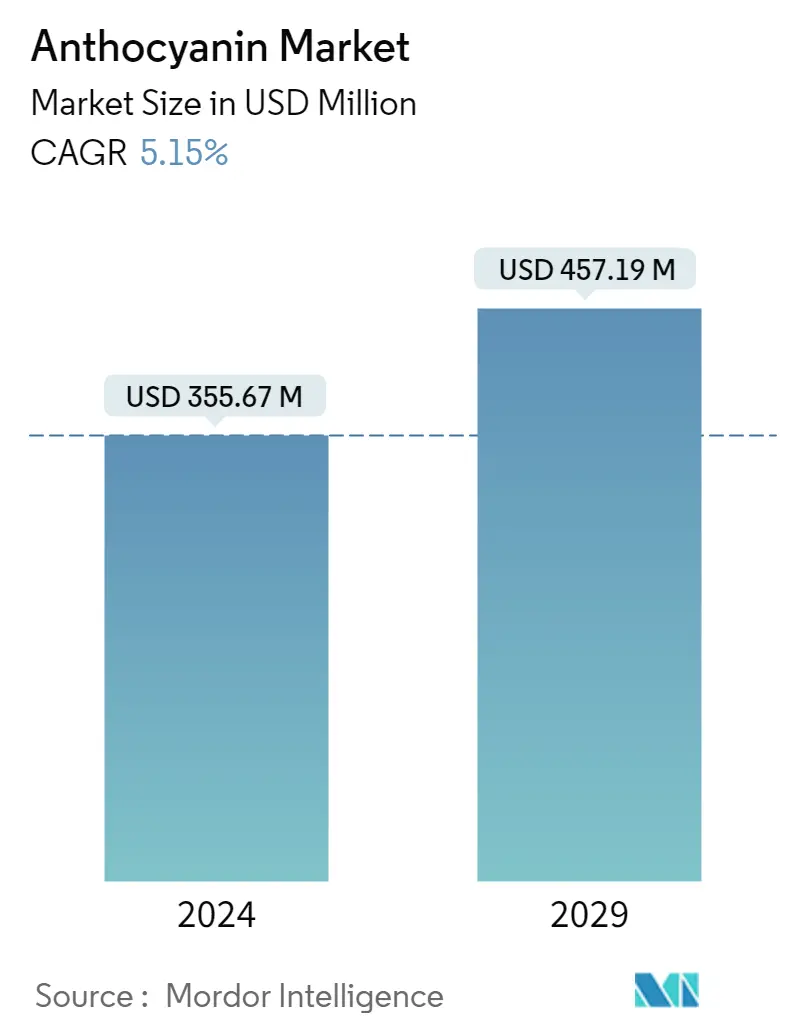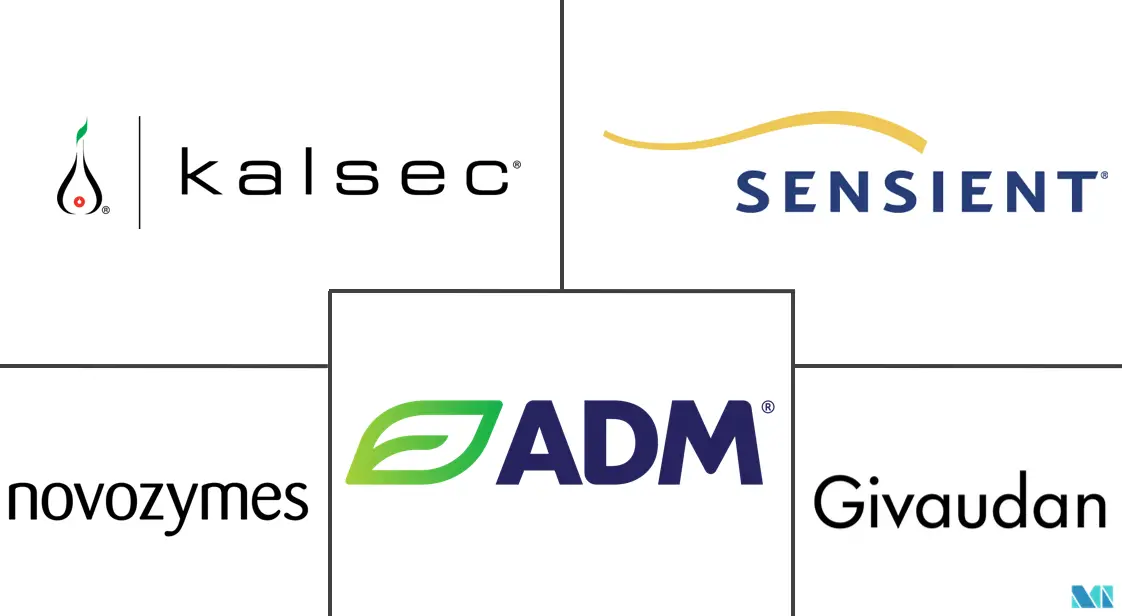Market Size of Anthocyanin Industry

| Study Period | 2019 - 2029 |
| Market Size (2024) | USD 355.67 Million |
| Market Size (2029) | USD 457.19 Million |
| CAGR (2024 - 2029) | 5.15 % |
| Fastest Growing Market | Asia-Pacific |
| Largest Market | North America |
Major Players
*Disclaimer: Major Players sorted in no particular order |
Anthocyanin Market Analysis
The Anthocyanin Market size is estimated at USD 355.67 million in 2024, and is expected to reach USD 457.19 million by 2029, growing at a CAGR of 5.15% during the forecast period (2024-2029).
Anthocyanin is found in many foods, including blueberries, blackberries, raspberries, strawberries, cherries, purple grapes, beets, red cabbage, and red beans. Due to its functional properties, such as anti-allergic, anti-diabetic, anti-microbial, anti-inflammatory, and antioxidant, the market is driven by its increasing demand in the food and beverage industries. The other health benefits include reducing the risk of heart disease and respiratory disorders, which fueled the market sales.
The natural anthocyanins food colorants are responsible for colors, such as red, purple, and blue, which are found in fruits and vegetables. Berries, currants, grapes, and tropical fruits have high anthocyanin content. Also, anthocyanins are a type of flavonoid, a class of compounds with antioxidant effects. In addition to acting as antioxidants and fighting free radicals, anthocyanins may offer anti-inflammatory, anti-viral, and anti-cancer benefits. The extracted anthocyanin pigment from purple carrots is increasingly being used as an alternative natural red colorant for preparing hard candy and sweet jelly. Moreover, red carrot pigment is being used as a natural antioxidant in sunflower oil to delay rancidity of sunflower oil. Therefore, these increased application areas of anthocyanin are expected to drive the segment, hence, the players have been offering products to suit the dynamic demands of the clients, for example, NiroWell and Healthy Food Ingredients (HFI) offer their line of extracted Suntava Purple Corn ingredients powder. This extract powder has gained traction within the baking industry, as the ingredient is suitable for use as a natural color option for many clean-label applications, including snack foods and beverages.
The food and beverage industries account for the largest share of the market owing to the natural colorant with many health benefits, and the personal care sector is witnessing an increasing market growth trend. However, they are a promising alternative to synthetic food dyes as anthocyanins do not lead to side effects and toxicity if overconsumed and create no health hazards. The synthetic food dyes sector still accounts for a good share of the market owing to the lower cost and high stability compared to natural colors such as anthocyanins, chlorophyll, carotenoids, and turmeric, thus being the major factor restraining the market.
Anthocyanin Industry Segmentation
Fruits, vegetables, nuts, seeds, and legumes are not only rich in vitamins and minerals but also contain a range of plant compounds that benefit your health. Anthocyanin is one such example. This antioxidant of the flavonoid family is purported to reduce inflammation and protect you from conditions like cancer, Alzheimer's disease, heart disease, and type 2 diabetes. Hence, anthocyanins that are derived from edible plants find their applications across various industries.
The anthocyanin market is segmented by type, application, and geography. Based on type, the market is segmented into cyanidin, malvidin, delphinidin, peonidin, and other types. Based on the application, the market is segmented into food and beverage, pharmaceutical, personal care products, and animal feed. Food and beverage are further sub-segmented into bakery & confectionery, dairy-based products, beverages, and other applications. The study also covers the global level analysis of the major regions such as North America, Asia-Pacific, Europe, South America, and the Middle East and Africa.
For each segment, the market sizing and forecasts have been done based on value (in USD million).
| Type | |
| Cyanidin | |
| Malvidin | |
| Delphinidin | |
| Peonidin | |
| Other Types |
| Application | ||||||
| ||||||
| Pharmaceutical | ||||||
| Personal Care | ||||||
| Animal Feed |
| Geography | |||||||||
| |||||||||
| |||||||||
| |||||||||
| |||||||||
|
Anthocyanin Market Size Summary
The anthocyanin market is poised for significant growth, driven by its increasing application in the food and beverage industries due to its functional properties such as anti-allergic, anti-diabetic, anti-microbial, anti-inflammatory, and antioxidant benefits. Found in a variety of fruits and vegetables, anthocyanins are gaining traction as natural colorants, offering a safe alternative to synthetic dyes, which are often linked to health concerns. The demand for natural food colorants is further bolstered by stringent regulations against synthetic colorants in several countries, fostering a shift towards safer, natural additives. This trend is supported by rising consumer awareness and preference for clean-label products, which is encouraging companies to innovate and expand their product offerings in the anthocyanin segment.
The market landscape is characterized by intense competition and fragmentation, with numerous regional and domestic players vying for market share. Leading companies such as Novozymes A/S, Kalsec Inc., Sensient Technologies Corporation, Archer Daniels Midland Company, and Givaudan are actively engaging in strategic mergers, acquisitions, and partnerships to enhance their market presence and product portfolios. The Asia-Pacific region is witnessing robust growth due to increasing consumer demand for healthy ingredients and rising disposable incomes. As companies expand their production capabilities and leverage social media to raise awareness, the anthocyanin market is expected to continue its upward trajectory, driven by both consumer preferences and regulatory support for natural colorants.
Anthocyanin Market Size - Table of Contents
-
1. MARKET DYNAMICS
-
1.1 Market Drivers
-
1.1.1 Increasing Consumer Awareness Regarding Natural Products
-
1.1.2 Growing Demand for Anthocyanin in Pharmaceutical Industry
-
-
1.2 Market Restraints
-
1.2.1 Easy Availability of Synthetic Food Colorant
-
-
1.3 Porter's Five Forces Analysis
-
1.3.1 Threat of New Entrants
-
1.3.2 Bargaining Power of Buyers/Consumers
-
1.3.3 Bargaining Power of Suppliers
-
1.3.4 Threat of Substitute Products
-
1.3.5 Intensity of Competitive Rivalry
-
-
-
2. MARKET SEGMENTATION
-
2.1 Type
-
2.1.1 Cyanidin
-
2.1.2 Malvidin
-
2.1.3 Delphinidin
-
2.1.4 Peonidin
-
2.1.5 Other Types
-
-
2.2 Application
-
2.2.1 Food & Beverage
-
2.2.1.1 Bakery & Confectionery
-
2.2.1.2 Dairy-based products
-
2.2.1.3 Beverages
-
2.2.1.4 Other Applications
-
-
2.2.2 Pharmaceutical
-
2.2.3 Personal Care
-
2.2.4 Animal Feed
-
-
2.3 Geography
-
2.3.1 North America
-
2.3.1.1 United States
-
2.3.1.2 Canada
-
2.3.1.3 Mexico
-
2.3.1.4 Rest of North America
-
-
2.3.2 Europe
-
2.3.2.1 Spain
-
2.3.2.2 United Kingdom
-
2.3.2.3 Germany
-
2.3.2.4 France
-
2.3.2.5 Italy
-
2.3.2.6 Russia
-
2.3.2.7 Rest of Europe
-
-
2.3.3 Asia-Pacific
-
2.3.3.1 China
-
2.3.3.2 Japan
-
2.3.3.3 India
-
2.3.3.4 Australia
-
2.3.3.5 Rest of Asia-Pacific
-
-
2.3.4 South America
-
2.3.4.1 Brazil
-
2.3.4.2 Argentina
-
2.3.4.3 Rest of South America
-
-
2.3.5 Middle-East and Africa
-
2.3.5.1 South Africa
-
2.3.5.2 Saudi Arabia
-
2.3.5.3 Rest of Middle-East and Africa
-
-
-
Anthocyanin Market Size FAQs
How big is the Anthocyanin Market?
The Anthocyanin Market size is expected to reach USD 355.67 million in 2024 and grow at a CAGR of 5.15% to reach USD 457.19 million by 2029.
What is the current Anthocyanin Market size?
In 2024, the Anthocyanin Market size is expected to reach USD 355.67 million.

